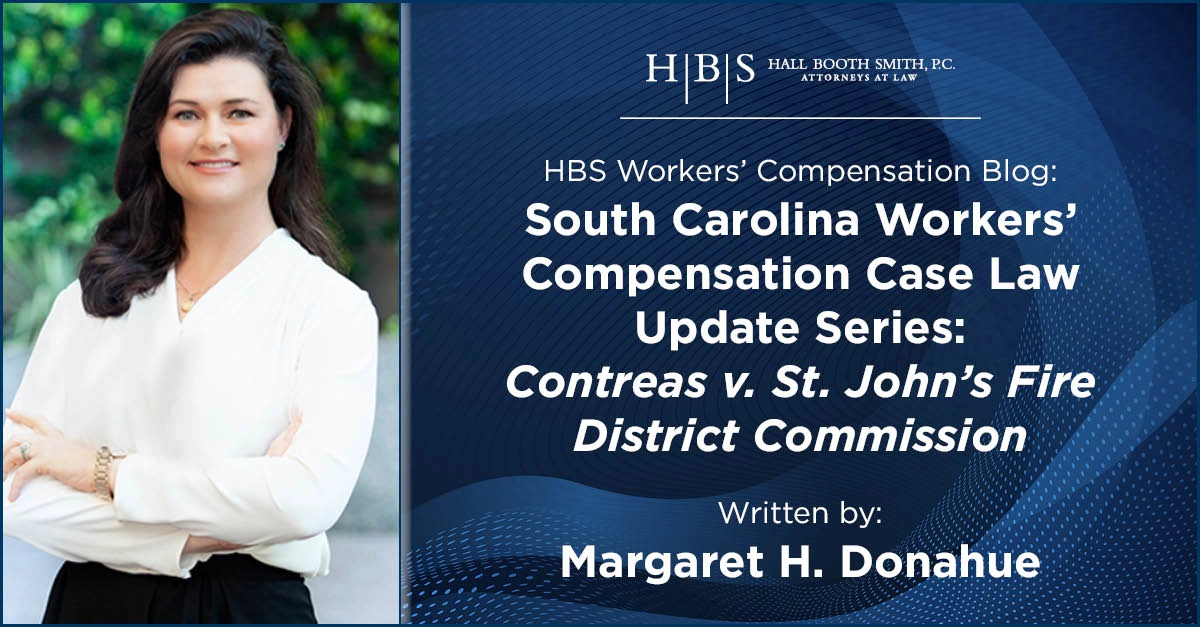
South Carolina Workers’ Compensation Case Law Update Series, Part II: Contreas v. St. John’s Fire District Commission
Background
The South Carolina appellate courts have been faced with several questions on workers’ compensation in recent months, producing opinions that will affect practice points and claims handling in defending workers compensation claims. In this series, I’ll discuss the rulings and how Employers and Carriers should be mindful of this precedent going forward.
The Case
Contreas v. St. John’s Fire District Commission, SC Court of Appeals, March 13, 2024
This case involves a shoulder injury with multiple surgeries, in which the Full Commission awarded permanent partial disability (PPD) based on a single-member injury to the shoulder. Claimant appeals, arguing that he should have been awarded permanency based on wage loss, alleging that he’d sustained impairment to more than one body part, allowing for permanency under Section 42-9-20. To boil down the medical history, Claimant underwent three shoulder surgeries and was placed at MMI, at which time his physician completed a Form 14B, Physician’s Statement, suggesting impairment to the shoulder and the upper extremity. Claimant later returned to the doctor with continued pain over the bicipital grove, resulting in a fourth surgery that included biceps tenodesis. Upon MMI after the last surgery, his doctor provided a rating on a new Form 14B indicating an increased rating to the shoulder only. In response to the Form 14B, the doctor was provided a check-box questionnaire on which he marked “yes” as to questions stating that the injury included and affected the upper extremity. The procedural history is similarly complicated, but the ultimate result was that the Full Commission ruled that this was a single-member injury to the shoulder and permanency was limited to PPD.
The first issue raised by Claimant involves alleged inconsistencies in the Full Commission’s findings between the Orders that make up the history in the case. The Court of Appeals disagrees and goes into detail in referencing points of evidence that the Full Commission weighed against or in support of other aspects of evidence, and why which piece of evidence was found to be more probative as to each issue. The Court ruled that the findings of the Full Commissioner were not inconsistent based on the Full Commission’s detailed findings as to how each piece of evidence was evaluated and applied.
When it comes to impairment ratings, a continual point of contention is the “also affected” body parts. We frequently see allegations of either or both legs as additional injuries on a primary back injury and, as in this case, the corresponding arm as part of a shoulder injury. In South Carolina, impairment to more than one body part opens the door for increased permanency under permanent and total disability (Section 42-9-10) or wage-loss (Section 42-9-20). Claimant argues that the evidence showed that he sustained separate impairment to his arm: as indicated by the biceps tenodesis procedure, noted biceps atrophy, and permanent pain in the biceps area of the arm. Thus, he contends, it should have been found that he sustained injuries to his shoulder and arm, supporting an award of permanency based on wage-loss. The Court disagreed.
The Court of Appeals based its ruling on the Substantial Evidence standard. It explained that the possibility of drawing two inconsistent conclusions did not prevent a finding from being supported by substantial evidence, but that competing evidence must be weighed in a reasonable manner. If reasonably weighed, the Commission’s findings of fact in regard to competing medical evidence are conclusive. The Court went on to note that finding of injury to a secondary body part required not only that the primary injury affected the other body part, but that the body part was “impaired.” The Court went on to discuss that the impairments were consistently assigned to the shoulder, and though there was some indication of consideration of the clavicle and the biceps being factored in, there was no diagnostic testing beyond that of the shoulder. The Court stated that the Full Commission had the authority to weigh [the conflicting] evidence and determine the extent of disability; from there, the Court of Appeals is constrained by its standard of review.
The defense bar has been on its guard since the shoulder became a separate scheduled member of just this scenario—allegations of separate injury and impairment to the arm, creating claims for increased permanency under the two-body-part rule. This case did not conclusively put that issue to bed, but it did maintain deference to the Commission to address secondary body part allegations on a case-by-case basis and showed a framework for dealing with competing evidence.
The evidence and the discussion in the ruling are specific to this case, but this highlights a key practice point for cases that go to hearing. As the prevailing party is tasked with drafting the proposed Order at the Single Commissioner and Full Commission level, and the Commission is the definitive finder of fact, detailed order drafting to support the findings on contested issues in the event of appeal is invaluable. So, don’t skimp on the details.
Disclaimer
This material is provided for informational purposes only. It is not intended to constitute legal advice nor does it create a client-lawyer relationship between Hall Booth Smith, P.C. and any recipient. Recipients should consult with counsel before taking any actions based on the information contained within this material. This material may be considered attorney advertising in some jurisdictions. Prior results do not guarantee a similar outcome.
Blog Overview
About the Author
Margaret H. “Meg” Donahue
Of Counsel | Charleston Office
T: 803.730.3978
E: mdonahue@hallboothsmith.com
Charleston Of Counsel Margaret H. “Meg” Donahue represents employers and insurance carriers in coverage disputes, compensability, permanency disputes, medically complex cases, and toxic exposure in the workplace. She advises clients in defensive strategy, claim valuation, and mitigation of risk and loss.




Leave a comment
You must be logged in to post a comment.